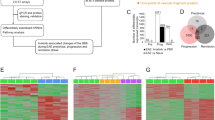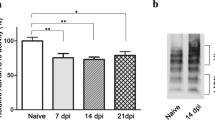Abstract
Kinins are bioactive peptides which provide multiple functions, including critical regulation of the inflammatory response. Released during tissue injury, kinins potentiate the inflammation which represents a hallmark of numerous neurological disorders, including those of autoimmune origin such as multiple sclerosis (MS). In the present work, we assess the expression of B1 receptor (B1R) in rat brain during the course of experimental autoimmune encephalomyelitis (EAE) which is an animal model of MS. We apply pharmacological inhibition to investigate the role of this receptor in the development of neurological deficits and in shaping the cytokine/chemokine profile during the course of the disease. Overexpression of B1R is observed in brain tissue of rats subjected to EAE, beginning at the very early asymptomatic phase of the disease. This overexpression is suppressed by a specific antagonist known as DALBK. The involvement of B1R in the progression of neurological symptoms in immunized rats is confirmed. Analysis of an array of cytokines/chemokines identified a sub-group as being B1R-dependent. Increase of the protein levels for the proinflammatory cytokines (Il-6, TNF-α but not IL-1β), chemokines attracting immune cells into nervous tissue (MCP-1, MIP-3α, LIX), and protein levels of fractalkine and vascular endothelial growth factor observed in EAE rats, were significantly diminished after DALBK administration. This may indicate the protective potential of pharmacological inhibition of B1R. However, simultaneously reduced protein levels of anti-inflammatory and neuroprotective factors (IL-10, IL-4, and CNTF) was noticed. The results show that B1R-mediated signaling regulates the cellular response profile following neuroinflammation in EAE.



Similar content being viewed by others
References
Argañaraz GA, Silva Jr JA, Perosa SR, Pessoa LG, Carvalho FF, Bascands JL, Bader M, da Silva Trindade E, Amado D, Cavalheiro EA, Pesquero JB, Naffah-Mazzacoratti M (2004) The synthesis and distribution of the kinin B1 and B2 receptors are modified in the hippocampus of rats submitted to pilocarpine model of epilepsy. Brain Res 1006:114–125
Austinat M, Braeuninger S, Pesquero JB, Brede M, Bader M, Stoll G, Renné T, Kleinschnitz C (2009) Blockade of bradykinin receptor B1 but not bradykinin receptor B2 provides protection from cerebral infarction and brain edema. Stroke 40:285–293
Banisor I, Leist TP, Kalman B (2005) Involvement of β-chemokines in the development of inflammatory demyelination. J Neuroinflamm 2:7
Bar-Or A, Oliveira EM, Anderson DE, Hafler DA (1999) Molecular pathogenesis of multiple sclerosis. J Neuroimmunol 100:252–259
Bhoola KD, Figueroa CD, Worthy K (1992) Bioregulation of kinins: kallikreins, kininogens and kininases. Pharmacol Rev 44:1–80
Calixto JB, Medeiros R, Fernandes ES, Ferreira J, Cabrini DA, Campos MM (2004) Kinin B1 receptors: key G-protein-coupled receptors and their role in inflammatory and painful processes. Br J Pharmacol 143P:803–818
Chandrasekar B, Melby PC, Sarau HM, Raveendran M, Perla RP, Marelli-Berg FM, Dulin NO, Singh IS (2003) Chemokine-cytokine cross-talk. The ELR + CXC chemokine LIX (CXCL5) amplifies a proinflammatory cytokine response via a phosphatidylinositol 3-kinase-NF-kappa B pathway. J Biol Chem 278:4675–4686
Choi P, Reiser H (1998) IL-4: role in disease and regulation of production. Clin Exp Immunol 113:317–319
Chomczynski P, Sacchi N (1987) The single-step method of RNA isolation by acid guanidinium thiocyanate-phenol-chloroform extraction: twenty-something years on. Nat Protoc 1:581–585
Constantinescu CS, Farooqi N, O'Brien K, Gran B (2011) Experimental autoimmune encephalomyelitis (EAE) as a model for multiple sclerosis (MS). British J Pharmacol 164(4):1079–1106
Christiansen SC, Eddleston J, Woessner KM, Chambers SS, Ye R, Pan ZK, Zuraw BL (2002) Up-regulation of functional kinin B1 receptors in allergic airway inflammation. J Immunol 169:2054–2060
Clark AK, Yip PK, Malcangio M (2009) The liberation of fractalkine in the dorsal horn requires microglial cathepsin S. J Neurosci 29:6945–6954
Clark AK, Staniland AA, Marchand F, Kaan TK, McMahon SB, Malcangio M (2010) P2X7-dependent release of interleukin-1beta and nociception in the spinal cord following lipopolysaccharide. J Neurosci 30:573–582
Costa-Neto CM, Dillenburg-Pilla P, Heinrich TA, Parreiras-e-Silva LT, Pereira MG, Reis RI, Souza PP (2008) Participation of kallikrein-kinin system in different pathologies. Int Immunopharmacol 8:135–142
Couture R, Harrisson M, Vianna RM, Cloutier F (2001) Kinin receptors in pain and inflammation. Eur J Pharmacol 429:161–176
Croxford AL, Spath S, Becher B (2015) GM-CSF in neuroinflammation: licensing myeloid cells for tissue damage. Trends Immunol 36:651–662
Dutra RC, Leite DF, Bento AF, Manjavachi MN, Patrício ES, Figueiredo CP, Pesquero JB, Calixto JB (2011) The role of kinin receptors in preventing neuroinflammation and its clinical severity during experimental autoimmune encephalomyelitis in mice. PLoSOne 6:e27875
Dutra RC, Bento AF, Leite DF, Manjavachi MN, Marcon R, Bicca MA, Pesquero JB, Calixto JB (2013) The role of kinin B1 and B2 receptors in the persistent pain induced by experimental autoimmune encephalomyelitis (EAE) in mice: evidence for the involvement of astrocytes. Neurobiol Dis 54:82–93
Germain L, Barabe J, Galeano C (1988) Increased blood concentration of des-Arg9-bradykinin in experimental allergic encephalomyelitis. J Neurol Sci 83:211–217
Glabinski AR, Bielecki B, Ransohoff RM (2003) Chemokine upregulation follows cytokine expression in chronic relapsing experimental autoimmune encephalomyelitis. Scand J Immunol 58:81–88
Göbel K, Pankratz S, Schneider-Hohendorf T, Bittner S, Schuhmann MK, Langer HF, Stoll G, Wiendl H, Kleinschnitz C, Meuth SG (2011) Blockade of the kinin receptor B1 protects from autoimmune CNS disease by reducing leukocyte trafficking. J Autoimmun 36:106–114
Grygorowicz T, Wełniak-Kaminska M, Struzynska L (2016) Early P2X7R-related astrogliosis in autoimmune encephalomyelitis. Mol Cell Neurosci 74:1–9
Guevara-Lora I (2012) Kinin-mediated inflammation in neurodegenerative disorders. Neurochem Int 61:72–78
Han MH, Hwang SI, Roy DB, Lundgren DH, Price JV, Ousman SS, Fernald GH, Gerlitz B, Robinson WH, Baranzini SE, Grinnell BW, Raine CS, Sobel RA, Han DK, Steinman L (2008) Proteomic analysis of active multiple sclerosis lesions reveals therapeutic targets. Nature 451(7182):1076–1081
Harrison JK, Jiang Y, Chen S, Xia Y, Maciejewski D, McNamara RK, Streit WJ, Salafranca MN, Adhikari S, Thompson DA, Botti P, Bacon KB, Feng L (1998) Role for neuronally derived fractalkine in mediating interactions between neurons and CX3CR1-expressing microglia. Proc Natl Acad Sci USA 95:10896–10901
Holman DW, Klei RS, Ransohoff RM (2011) The blood-brain barrier, chemokines and multiple sclerosis. Biochim Biophys Acta 1812:220–230
Huang D, Shi FD, Jung S, Pien GC, Wang J, Salazar-Mather TP, He TT, Weaver JT, Ljunggren HG, Biron CA, Littman DR, Ransohoff RM (2006) The neuronal chemokine CX3CL1/fractalkine selectively recruits NK cells that modify experimental autoimmune encephalomyelitis within the central nervous system. FASEB J 20:896–905
Karpus WJ, Ransohoff RM (1998) Chemokine regulation of experimental autoimmune encephalomyelitis: temporal and spatial expression patterns govern disease pathogenesis. J Immunol 161:2667–2671
Kerschensteiner M, Stadelmann C, Buddeberg BS, Merkler D, Bareyre FM, Anthony DC, Linington C, Bruck W, Schwab ME (2004) Animal model—targeting experimental autoimmune encephalomyelitis lesions to a predetermined axonal tract system allows for refined behavioral testing in an animal model of multiple sclerosis. Am J Pathol 164:1455–1469
Kis B, Chen L, Ueta Y, Busija DW (2006) Autocrine peptide mediators of cerebral endothelial cells and their role in the regulation of blood-brain barrier. Peptides 27:211–222
Kohler RE, Caon A, Willenborg DO, Mccoll SRA (2003) Role for macrophage inflammatory protein-3/CC chemokine ligand 20 in immune priming during T cell-mediated inflammation of the central nervous system. J Immunol 170:6298–6306
Leeb-Lundberg LM, Marceau F, Müller-Esterl W, Pettibone DJ, Zuraw B (2005) International union of pharmacology. XLV. Classification of the kinin receptor family: from molecular mechanisms to pathophysiological consequences. Pharmacol Rev 57:27–77
Link H (1998) The cytokine storm in multiple sclerosis. Mult Scler 4:12–15
Linker RA, Mäurer M, Gaupp S, Martini R, Holtmann B, Giess R, Rieckmann P, Lassmann H, Toyka KV, Sendtner M, Gold R (2002) CNTF is a major protective factor in demyelinating CNS disease: a neurotrophic cytokine as modulator in neuroinflammation. Nat Med 8:620–624
Lock C, Hermans G, Pedotti R, Brendolan A, Schadt E, Garren H, Langer-Gould A, Strober S, Cannella B, Allard J, Klonowski P, Austin A, Lad N, Kaminski N, Galli SJ, Oksenberg JR, Raine CS, Heller R, Steinman L (2002) Gene-microarray analysis of multiple sclerosis lesions yields new targets validated in autoimmune encephalomyelitis. Nat Med 8:500–508
Lowry OW, Rosenbrough NJ, Farr AL, Randal RJ (1951) Protein measurement with Folin phenol reagent. J Biol Chem 193:265–275
Marceau F, Hess JF, Bachvarov DR (1998) The B1 receptors for kinins. Pharmacol Rev 50:357–386
Matejuk A, Dwyer J, Ito A, Bruender Z, Vandenbark AA, Offner H (2002) Effects of cytokine deficiency on chemokine expression in CNS of mice with EAE. J Neurosci Res 67:680–688
Melder RJ, Koenig GC, Witwer BP, Safabakhsh N, Munn LL, Jain RK (1996) During angiogenesis, vascular endothelial growth factor and basic fibroblast growth factor regulate natural killer cell adhesion to tumor endothelium. Nat Med 2:992–997
Mills JH, Alabanza LM, Mahamed DA, Bynoe MS (2012) Extracellular adenosine signaling induces CX3CL1 expression in the brain to promote experimental autoimmune encephalomyelitis. J Neuroinflamm 9:193
Phagoo SB, Poole S, Leeb-Lundberg LM (1999) Autoregulation of bradykinin receptors: agonists in the presence of interleukin-1beta shift the repertoire of receptor subtypes from B2 to B1 in human lung fibroblasts. Mol Pharmacol 56:325–333
Proescholdt MA, Jacobson S, Tresser N, Oldfield EH, Merrill MJ (2002) Vascular endothelial growth factor is expressed in multiple sclerosis plaques and can induce inflammatory lesions in experimental allergic encephalomyelitis rats. J Neuropathol Exp Neurol 61:914–925
Ransohoff RM (2016) How neuroinflammation contributes to neurodegeneration. Science 353:777–783
Raslan F, Schwarz T, Meuth SG, Austinat M, Bader M, Renné T, Roosen K, Stoll G, Sirén AL, Kleinschnitz C (2010) Inhibition of bradykinin receptor B1 protects mice from focal brain injury by reducing blood-brain barrier leakage and inflammation. J Cereb Blood Flow Metab 30:1477–1486
Schottelius AJG, Mayo MW, Sartor RB, Baldwin AS Jr (1999) Interleukin-10 signaling blocks inhibitor of κB kinase activity and nuclear factor κB DNA binding. J Biol Chem 274:31868–31874
Schremmer-Danninger E, Hermann A, Fink E, Fritz H, Roscher AA (1999) Identification and occurrence of mRNAs for components of the kallikrein-kinin system in human skin and in skin diseases. Immunopharmacology 43:287–291
Schulze-Topphoff U, Prat A, Prozorovski T, Siffrin V, Paterka M, Herz J, Bendix I, Ifergan I, Schadock I, Mori MA, Van Horssen J, Schröter F, Smorodchenko A, Han MH, Bader M, Steinman L, Aktas O, Zipp F (2009) Activation of kinin receptor B1 limits encephalitogenic T lymphocyte recruitment to the central nervous system. Nat Med 15:788–793
Schwartz M, Deczkowska A (2016) Neurological disease as a failure of brain-immune crosstalk: the multiple faces of neuroinflammation. Trends Immunol S1471 4906(16)30090-4
Shcherbakova I, Neshkova E, Dotsenko V, Platonova T, Shcherbakova E, Yarovaya G (1999) The possible role of plasma kallikrein-kinin system and leukocyte elastase in pathogenesis of schizophrenia. Immunopharmacology 43:273–279
Silva JA Jr, Goto EM, Perosa SR, Argañaraz GA, Cavalheiro EA, Naffah-Mazzacoratti MG, Pesquero JB (2008) Kinin B1 receptors facilitate the development of temporal lobe epilepsy in mice. Int Immunopharmacol 8:197–199
Sulkowski G, Dąbrowska-Bouta B, Chalimoniuk M, Strużyńska L (2013) Effects of antagonists of glutamate receptors on pro-inflammatory cytokines in the brain cortex of rats subjected to experimental autoimmune encephalomyelitis. J Neuroimmunol 261:67–76
Walker K, Perkins M, Dray A (1995) Kinins and kinin receptors in the nervous system. Neurochem Int 26:1–16
Zhu W, Acosta C, MacNeil B, Cortes C, Intrater H, Gong Y, Namaka M (2013) Elevated expression of fractalkine (CX3CL1) and fractalkine receptor (CX3CR1) in the dorsal root ganglia and spinal cord in experimental autoimmune encephalomyelitis: implications in multiple sclerosis-induced neuropathic pain. Biomed Res Int 2013:480702
Acknowledgements
This work was supported by funds from the Polish Ministry of Scientific Research and Higher Education for the KNOW-MMRC project.
Author information
Authors and Affiliations
Corresponding author
Ethics declarations
Conflict of interest
The authors declare that they have no conflict of interest.
Rights and permissions
About this article
Cite this article
Podsiadło, K., Sulkowski, G., Dąbrowska-Bouta, B. et al. Blockade of the kinin B1 receptor affects the cytokine/chemokine profile in rat brain subjected to autoimmune encephalomyelitis. Inflammopharmacol 25, 459–469 (2017). https://doi.org/10.1007/s10787-017-0312-9
Received:
Accepted:
Published:
Issue Date:
DOI: https://doi.org/10.1007/s10787-017-0312-9




